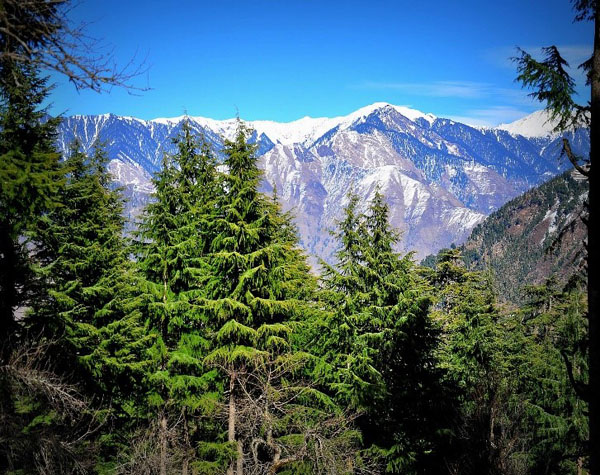Written By Aruditya Singh Jasrotia
TheJodiyan Mata temple is located in Jodiayn village and it is dedicated to Goddess Durga. Temple is located in district kathua (Jammu & Kashmir). Jodiyan temple is a situated at Banjal (Himalaya) near 80 Km away from Basholi Town. Basholi is a town in Kathua district and it is situated on the right bank of River Ravi at an altitude of 1876 ft. The residents of Jodiyan and the nearby villages believe that goddess durga protects the flora and fauna of the hills.

As per the locals, few decades ago a shepherd discovered the place while moving with the cattle. He witnessed that his cattle go into deep sleep when left around the area. He got curious and with the help of a spiritual leader discovered that this place is religious. From the story it’s clear that religious sentiments of the community are attached with the place. It is a colorful area with lot of flowers blooming also known as “Garden of Natural Flowers.” You can go by bus or private vehicle till Poond Village, from there you have to trek. Jodiyan Di Mata is a religious center which is visited by hundreds of pilgrims during Navratras. Voluntary groups help in providing basic facilities to pilgrims. The temple is at the altitude of about 7,000 ft. Jodiyan Di Mata commands lot of faith of local people. It is also a beautiful place, full of natural beauty.
The trek from the Poond village till Jodiyan Mata Temple is approximately 15 km. Best time to visit is Navratras (Chet Month and Sarad Ritu Month- Hindu Calendar). One can see the snow covered peaks of Himalaya of Mani Mahesh (Lord Shiva) from the Jodiyan Mata Temple. Dormitory to stay is available beside the temple. The visitors have to adopt the village lifestyle while visiting this place because there are no hotels, restaurants, roads in the area. Because of these reasons the trek for Jodiyan Mata has become favorite place for adventure lovers and youngsters. Slowly this place is getting popular for trekking, camping and adventure trips. From the starting point of the trek till the Jodiyan temple there are small villages and the people from the villages earn their livelihood by providing service like food, horse/ pony rides, toys etc. to the visitors and tourists.
When I visited the place last year I noticed that currently the local community is facing problems like poverty, lack of education, lack of infrastructure. Locals are not aware about the outcomes of the increasing tourist activities. One of the biggest concerns of residents is the lack of an accessibility and facilities in the village. Some other expressed an interest in constructing a governing body to monitor the activities of the tourists. Impacts of the growing tourist activities are becoming visible slowly in the form of exploitation of flora and fauna, non-degradable waste etc. Agriculture is a prominent source of income and food for the locals which will ultimately get affected by such activities. The environment of the Banjal hills is fragile and precautions need to be taken now so that in future when this undiscovered destinations becomes popular, a proper plan is available with the authorities for the betterment of the community.
Read also: Things to know about Ranbir Canal: Lifeline of Jammu
As the tourism in the area is in infant stage, it is the right time to mold it to a direction which would maximize the positive impact of tourism in the area. On the visit I recognized that if the community of Jodiyan and nearby villages is going to gain acceptance and financial backing from tourism, then a properly structured and democratically composed community plan would be vital. This would not only provide authentic and unique experience to the adventuresome visitors arriving at the place but also provide the maximum benefit of such type of tourism to the members of the community. A Community Led Plan, will be best suitable for this case. A Community Led Plan is a process that underpins a community’s vision for itself across all aspects of social, environmental and economic life. It celebrates positive features and activities, highlights local needs and contains a detailed action plan to help meet those needs. These plans are produced by and for communities, based on a detailed survey and consultation which is widely inclusive, prompts action and influences others.
Community of a destination is considered to be the most important stakeholder when it comes to developing tourism in the particular area. The locals are the ones who know their place the best. They are the people who should be given the prime power to decide whether or not tourism related activities should be practiced in their area.
















